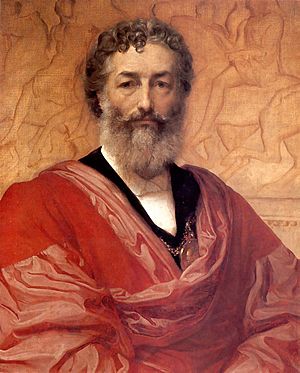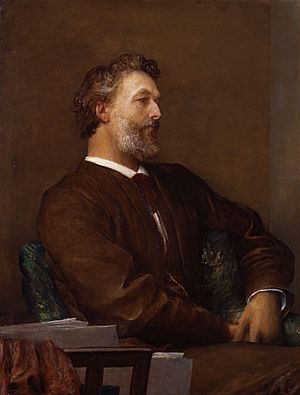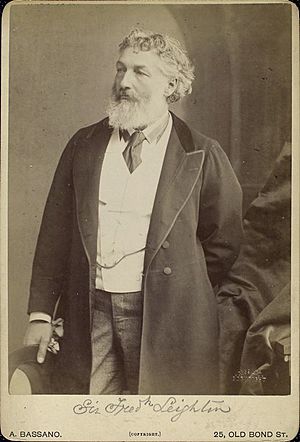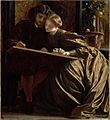Frederic Leighton facts for kids
Quick facts for kids
The Lord Leighton
PRA
|
|
|---|---|

Frederic Leighton, Self-portrait, 1880
|
|
| Born |
Frederic Leighton
3 December 1830 Scarborough, North Riding of Yorkshire, England
|
| Died | 25 January 1896 (aged 65) Kensington, London, England
|
| Education | Eduard von Steinle Giovanni Costa |
| Known for | Painting and sculpture |
|
Notable work
|
Flaming June |
| Movement | Academicism, Pre-Raphealite and British Aestheticism |
| Awards | Prix de Rome Légion d'honneur |
Frederic Leighton was a very famous British painter, draughtsman, and sculptor. He lived from 1830 to 1896. His artworks often showed scenes from history, the Bible, and ancient Greek and Roman times. He painted in a style called academicism.
During his lifetime, Leighton's paintings were incredibly popular and very expensive. He was known as Sir Frederic Leighton for many years. He also held the shortest-lived peerage (a special title of nobility) in history. He received the title of Baron Leighton just one day before he passed away.
Contents
Frederic Leighton's Life
Frederic Leighton was born in Scarborough, England. His parents were Augusta Susan and Dr. Frederic Septimus Leighton. He had two sisters, including Alexandra, who wrote about the poet Robert Browning.
Leighton went to school at University College School in London. He then traveled to Europe to learn art. He studied with famous artists like Eduard von Steinle and Giovanni Costa. When he was 17, he met the philosopher Arthur Schopenhauer in Germany and drew his picture.
At 24, Leighton was in Florence, Italy. He studied at the Accademia di Belle Arti. There, he painted a famous artwork showing the procession of the Cimabue Madonna. From 1855 to 1859, he lived in Paris, France. He met many important artists there, including Ingres and Delacroix.
In 1860, Leighton moved to London. He became friends with the Pre-Raphaelites, a group of artists. He designed the tomb for Elizabeth Barrett Browning in Florence in 1861. In 1864, he became a member of the Royal Academy. This is a famous art institution in Britain. He later became its President in 1878 and held that role until he died in 1896.
Leighton also created sculptures. His 1877 sculpture, Athlete Wrestling with a Python, was very important. It helped start a new movement in British sculpture called the New Sculpture. His paintings were shown at the big Paris Exhibition in 1900, representing Britain.
Leighton was made a knight in 1878. Eight years later, he became a baronet. This was a special honor. In 1896, he was the first painter ever to be given a peerage. This meant he became a Baron. The official document making him Baron Leighton was issued on January 24, 1896. Sadly, he died the very next day, on January 25, 1896, from a heart condition.
Because he died so soon after getting his title, his barony lasted only one day. This is a record in the history of British peerages. His home in Holland Park, London, is now a museum called the Leighton House Museum. It has many of his drawings and paintings. It also shows some of the art he collected, including works by older masters and his friends. The museum is famous for its beautiful Arab Hall, which has many colorful tiles.
Leighton as a Soldier

Frederic Leighton was also a very eager volunteer soldier. He joined the 38th Middlesex (Artists') Rifle Volunteer Corps in 1860. This group later became known as the Artists Rifles.
Leighton was a natural leader. He was quickly promoted to command a Company within a few months. In 1869, he was chosen to lead the Artists Rifles. He became a major in the same year and a lieutenant colonel in 1875. Leighton stopped being the commanding officer in 1883.
The painter James Whistler once joked about Leighton. He called him the "Colonel of the Royal Academy and the President of the Artists Rifles – aye, and he paints a little!" This shows how important Leighton was in both art and the military. When Leighton died, his coffin was carried into St Paul's Cathedral. A special guard of honour was formed by the Artists Rifles to show their respect.
Awards and Recognition
Frederic Leighton received many honors during his life:
- 1864: Became an Associate of the Royal Academy.
- 1868: Became a full Academician of the Royal Academy.
- 1878: Became President of the Royal Academy.
- 1878: Received the Légion d'honneur (a French award).
- 1878: Was made a Knight Bachelor.
- 1886: Was created a baronet in the Baronetage of the United Kingdom.
- 1889: Became an associate member of the Institute of France.
- 1896: Was created a baron in the Peerage of the United Kingdom.
Famous Artworks
Here are some of Frederic Leighton's well-known artworks:
- Death of Brunelleschi (1852)
- The Fisherman and the Siren, c. 1856–58
- Cimabue's Celebrated Madonna Is Carried in Procession Through the Streets of Florence (1853–55)
- The Discovery of Juliet Apparently Lifeless (c.1858)
- The Painter's Honeymoon, c. 1864
- Actaea, the Nymph of the Shore (1868)
- Daedalus and Icarus, c. 1869
- Hercules Wrestling with Death for the Body of Alcestis (1869–71)
- After Vespers 1871
- Greek Girls Picking up Pebbles by the Sea, 1871
- An Athlete Wrestling with a Python (1877), a bronze sculpture
- Nausicaa, c. 1878
- Winding the Skein, c. 1878
- Light of the Harem, c. 1880
- Cymon and Iphigenia (1884)
- Captive Andromache, c. 1888
- The Bath of Psyche, (c. 1889–90)
- The Garden of the Hesperides, c. 1892
- Flaming June (1895)
- Phoenicians Trading with the Early Britons on the Coast of Cornwall, 1895 (a mural)
- The Return of Persephone 1891
Gallery
-
Athlete wrestling with a Python, white marble sculpture, 1888–1891 (Private collection: on loan to the Art Gallery of New South Wales)
-
Moses views the Promised Land
-
Captive Andromache, oil on canvas painting, 1886–1888, Manchester City Art Gallery
-
Cymon and Iphigenia, oil on canvas painting, 1884, Art Gallery of New South Wales
-
Portrait of May Sartoris at about 15 years of age, Kimbell Art Museum, Fort Worth, TX.
See also
 In Spanish: Frederic Leighton para niños
In Spanish: Frederic Leighton para niños


















